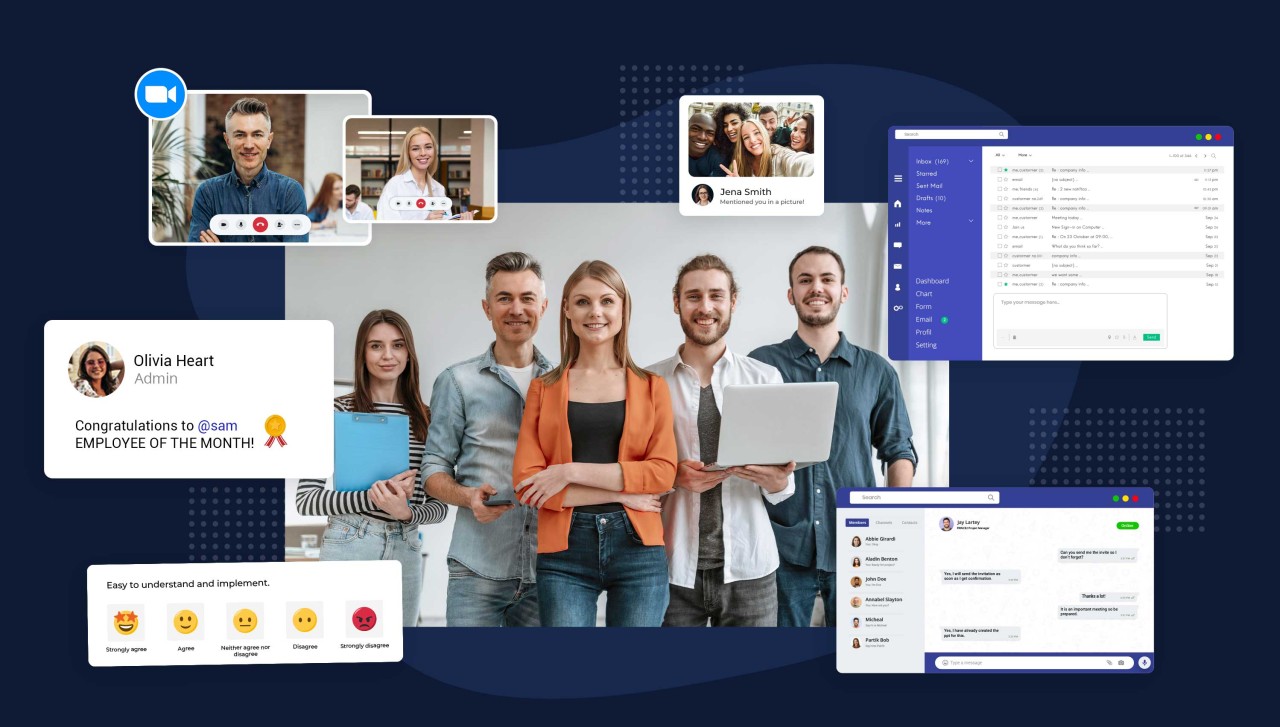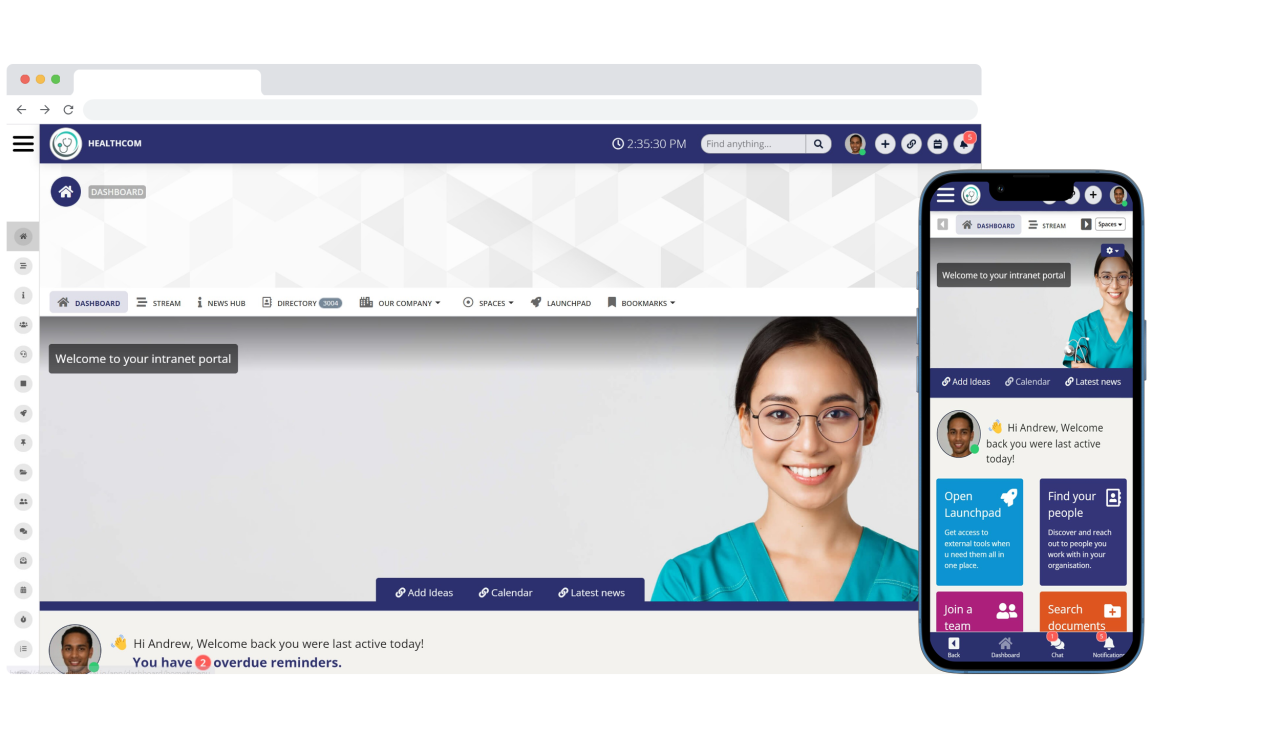Insight Blog
Agility’s perspectives on transforming the employee's experience throughout remote transformation using connected enterprise tools.
13 minutes reading time
(2588 words)
Bridging Communication Gaps in the Workplace for Better Productivity Among Remote Employees
Continue reading to gain a deeper understanding of what communication gaps entail, how they detrimentally affect your organization's productivity and safety, and effective strategies to rectify these issues.
On average, employees dedicate more than 30% of their workday to email, not to mention the additional time spent on Slack, Zoom calls, and in-person meetings. This often leaves little room to focus on actual job tasks.
Communication plays a pivotal role in the day-to-day operations of nearly every organization. However, both employees and supervisors frequently lament the productivity toll exacted by emails and meetings, yearning for a more efficient alternative. Nevertheless, laying the blame on communication tools like email, AgilityPortal, Slack, Zoom, and other apps is often a misguided approach.
Rather than pointing fingers at the tools themselves, it's more fruitful to scrutinize the junctures where communication breaks down. Where do top-down messages miss their mark? Why do team members struggle to convey information accurately and efficiently? Identifying these areas unveils the true culprits responsible for decreased productivity—communication gaps.
Communication plays a pivotal role in the day-to-day operations of nearly every organization. However, both employees and supervisors frequently lament the productivity toll exacted by emails and meetings, yearning for a more efficient alternative. Nevertheless, laying the blame on communication tools like email, AgilityPortal, Slack, Zoom, and other apps is often a misguided approach.
Rather than pointing fingers at the tools themselves, it's more fruitful to scrutinize the junctures where communication breaks down. Where do top-down messages miss their mark? Why do team members struggle to convey information accurately and efficiently? Identifying these areas unveils the true culprits responsible for decreased productivity—communication gaps.
Continue reading to gain a deeper understanding of what communication gaps entail, how they detrimentally affect your organization's productivity and safety, and effective strategies to rectify these issues.
What Are Communication Gaps in the Workplace?
Communication gaps are miscommunications that happen when information is not conveyed or received correctly. This can be caused by the person giving the information, the person receiving the information, or both.
Communication gaps can happen in any workplace setting, including:
- One-on-one conversations between coworkers
- Supervisor and subordinate interactions
- Mass emails, intranet posts, or other company-wide communications
- Group meetings and conference calls
Here are some examples of communication gaps:
- A manager gives a team member instructions, but the team member misunderstands what they need to do.
- An employee sends a mass email with important information, but some employees don't receive the email or don't read it carefully.
- Two employees are working on a project together, but they don't communicate regularly and end up working on different parts of the project that don't fit together.
- A team has a meeting, but some team members don't participate or they don't pay attention.
Communication gaps can lead to a number of problems, including:
- Mistakes and rework
- Missed deadlines
- Conflict and frustration
- Decreased productivity and morale
There are a number of things that individuals and organizations can do to bridge communication gaps, such as:
- Be clear and concise when communicating.
- Use active listening skills.
- Ask clarifying questions.
- Provide feedback.
- Encourage open communication.
- Invest in communication training.
By taking steps to bridge communication gaps, individuals and organizations can create a more productive and positive work environment.
What causes gaps in communication?
Effective communication operates as a two-way thoroughfare, with potential breakdowns occurring on either side—or even on both sides, in some instances.
The most prevalent causes of communication gaps encompass:
- Physical Barriers - On occasion, physical impediments can obstruct communication. These barriers might encompass geographical distances, cubicle partitions, closed office doors, or ambient noise sources such as exhaust fans or heavy machinery.
- Cultural Differences - In our increasingly globalized world, communication often involves individuals from diverse cultures and backgrounds. Variations in communication styles, including body language, tone of voice, and word choice, can convey disparate meanings and result in significantly different interpretations of the same information.
- Emotional Factors - Feelings of fear, anxiety, or distrust can lead individuals to provide and interpret information inaccurately, contributing to communication breakdowns.
- Interpersonal Issues - While workplace professionalism is a guiding principle, human imperfections persist. Personality clashes can occasionally give rise to communication challenges.
- Contextual Discrepancies - Effective communication relies on a shared context between the speaker and the listener. For example, if an accountant and a welder attempted to instruct each other about their respective roles, they would likely lack the necessary context to convey their expertise adequately.
Addressing these potential causes of communication gaps is crucial to fostering effective and productive communication within an organization.
What are the risks of incomplete workplace communication?
In many instances, miscommunication, or even a complete lack of communication, can result in minor operational inefficiencies and reduced productivity.
When instructions are misunderstood or not communicated clearly, it can lead to tasks being performed incorrectly, ultimately wasting time and resources. What's more, these initial missteps often exacerbate communication gaps, as the resulting frustration can strain conversations, perpetuating a cycle of minor issues.
However, the ramifications of communication gaps extend beyond mere operational inefficiencies; they can also pose safety hazards. For example, consider a scenario in which a work crew is operating an unfamiliar heavy machine at a job site.Despite receiving a safety briefing from the foreman, the workers hesitate to seek clarification because the foreman's use of technical jargon leaves them feeling intimidated. This communication gap elevates the safety risk for those using the machinery.
Moreover, communication gaps can give rise to long-term risks. When employees perceive their employer as lacking transparency, it erodes their trust in the company.
Moreover, communication gaps can give rise to long-term risks. When employees perceive their employer as lacking transparency, it erodes their trust in the company.
According to findings from the 2023 Employee Safety Report, failing to disclose a workplace emergency can trigger various adverse reactions among employees, ranging from feeling unsafe to actively seeking new employment or even reaching out to the media (refer to the chart on the right for further insights).
Follow us and access great exclusive content everyday: Follow us on Google News
How do you resolve communication gaps?
The crucial first step in resolving communication issues involves identifying the underlying cause. To illustrate this, consider a scenario where you hold the position of VP of Sales in an international company.
During a team-wide conference call focused on training and professional development, you use the phrase, "sell a ketchup popsicle to someone in white gloves," to express your expectations.
A week later, you discover that your team in the German office has been actively researching how to create a ketchup popsicle.
A week later, you discover that your team in the German office has been actively researching how to create a ketchup popsicle.
Clearly, a communication gap exists, but there could be several potential factors contributing to this misunderstanding:
1. You utilized terminology, in this case, an expression, that not everyone on the team had the necessary context to comprehend.
2. Differences in cultural norms across various parts of the team may have led to divergent interpretations of your statement.
3. The team in the German office might not have felt comfortable seeking clarification regarding your intended meaning.
1. You utilized terminology, in this case, an expression, that not everyone on the team had the necessary context to comprehend.
2. Differences in cultural norms across various parts of the team may have led to divergent interpretations of your statement.
3. The team in the German office might not have felt comfortable seeking clarification regarding your intended meaning.
Each of these scenarios holds merit and warrants investigation.
However, the most expedient and reliable way to prevent future misunderstandings is through open and transparent dialogue about what actually transpired.
5 Strategies for Bridging Communication Gaps
Addressing communication gaps can be a formidable task, yet throughout human history, we've witnessed a continuous narrative of individuals discovering fresh and inventive methods to exchange information.
Armed with an awareness of the underlying issues and a commitment to resolve them, you have the potential to cultivate enhanced communication within your organization.
To that end, here are five strategies to enhance your internal communication.
You may also like: Best Apps for Employees: UPDATED 2022 – A Complete Guide
1.Ensure open and honest dialogue
Fear and negative emotions often serve as significant catalysts for communication gaps, with a fundamental lack of employee trust frequently lying at their core. For effective information exchange within your organization, individuals must believe that their perspectives will be acknowledged and respected under any circumstances.
Cultivating a culture of trust and openness requires continuous efforts to safeguard employees' ability to communicate:
Cultivating a culture of trust and openness requires continuous efforts to safeguard employees' ability to communicate:
- Establish feedback mechanisms that guarantee leadership's receptiveness and responsiveness to employee concerns.
- Foster top-down communication characterized by honesty, clarity, and empathy.
- Encourage employees to freely express their concerns, suggestions, and ideas for the company's growth and enhancement.
- Provide clear guidance on dispute resolution and proactively address issues to prevent them from escalating or festering.
By diligently implementing these practices, you can foster an environment where trust thrives, facilitating more effective communication throughout your organization.
2.Ensure context is relevant
Consider the sheer volume of information that inundates your work life daily—company-wide announcements, departmental updates, and a deluge of messages from colleagues, vendors, and partners. How many of these communications truly hold significance for you, containing valuable information?
As Dr. Keri K. Stephens, an authority in organizational crisis communication, emphasized on The Employee Safety Podcast, inadequate messaging stands as a formidable stumbling block in workplace communication. She pointed out, "Often, we don't allocate sufficient time; we simply dispatch an email."
Rather than overwhelming individuals with a torrent of information, adopt a purposeful approach to team communication.
As Dr. Keri K. Stephens, an authority in organizational crisis communication, emphasized on The Employee Safety Podcast, inadequate messaging stands as a formidable stumbling block in workplace communication. She pointed out, "Often, we don't allocate sufficient time; we simply dispatch an email."
Rather than overwhelming individuals with a torrent of information, adopt a purposeful approach to team communication.
When composing an email or document, consider the following:
- Does the information hold significance for all recipients?
- Are there any key stakeholders who should be included in the audience?
- Am I presenting the information with utmost clarity and actionability?
- What is the most effective channel for disseminating this information?
By conscientiously addressing these questions, you can ensure that your communications are not only more effective but also more meaningful to your audience.
Free ebook: How To Get Your Intranet Off The Ground
3.Prioritize transparency
In large organizations, it's often unconsciously easy to compartmentalize information. Different departments gather data and information, each employing their unique tools, terminology, and acronyms, and they may not consistently share this valuable knowledge with other units that could benefit from it.
At the very least, these information silos create organizational challenges and inefficiencies, resulting in delays and unnecessary expenses. At worst, they can engender significant misunderstandings and erode trust, especially when the information pertains to safety. Whenever employees require access to data, it's imperative to ensure that it's easily accessible and comprehensible.
At the very least, these information silos create organizational challenges and inefficiencies, resulting in delays and unnecessary expenses. At worst, they can engender significant misunderstandings and erode trust, especially when the information pertains to safety. Whenever employees require access to data, it's imperative to ensure that it's easily accessible and comprehensible.
For instance:
- Rather than tucking away OSHA-mandated safety posters in obscure corners of your building, make sure this crucial information is readily accessible.
- Provide regular reports on company safety metrics and offer detailed data whenever it's relevant and necessary.
- Offer employees designated points of contact to reach out to if they have questions or need assistance in grasping the information.
- Steer clear of technical jargon that might confound some employees; instead, elucidate concepts using clear, straightforward, and simple language.
By adopting these practices, you can break down information silos, ensuring that valuable knowledge is not only shared but also readily understood and accessible across your organization.
4.Set company-wide communication standards
Establishing clear expectations can significantly mitigate communication gaps. Your organizational communication strategy should encompass standards for two vital domains:
By delineating expectations in these areas, you not only enhance communication effectiveness but also reduce the likelihood of misunderstandings and communication breakdowns within your organization.
- Peer-to-peer communication: While some aspects of communication may be self-evident—such as refraining from profanity-laden outbursts—many facets warrant specific guidelines to promote effective communication. Define explicit rules for the appropriate use of various communication methods. For instance, discourage the use of email for emergency notifications, as employees may not check it promptly. Instead, opt for text messages, which are more suitable for garnering recipients' immediate attention.
- Top-down communication: Develop a communication framework that delineates language, terminology, and channels to ensure universal accessibility and comprehension of information. Implement testing protocols, particularly for critical communications, such as those disseminated through your company's mass notification platform.
By delineating expectations in these areas, you not only enhance communication effectiveness but also reduce the likelihood of misunderstandings and communication breakdowns within your organization.
5.Implement effective multichannel messaging
Lastly, it's crucial to communicate through channels that the intended recipients prefer.
For instance, office workers typically have constant access to email, while construction workers may not check their messages for extended periods.
During a crisis, efficient two-way communication becomes especially vital, as the swift exchange of information is imperative, and any delays could potentially result in injuries and unnecessary risks to your team.
Nevertheless, merely transmitting messages through diverse channels is insufficient—you must also tailor your content accordingly. For instance, if you take a lengthy email and simply forward it as a text message, the reader's experience may suffer. It could arrive in fragments, out of sequence, or some parts might not reach the recipient at all.
Both scenarios create confusion, which can be catastrophic during an emergency.
Always consider the communication medium being used and ensure that the content is adapted to how the recipient will best absorb and comprehend the information.
How can an employee communication platform help solve Bridging Communication Gaps in the Workplace for Productivity for remote teams?
Employee communication platforms such as AgilityPortal can help solve bridging communication gaps in the workplace for productivity for remote teams in a number of ways:
- Provide a central communication hub. Employee communication platforms can provide a central hub where employees can access all of the information they need, such as company news, announcements, policies, and procedures. This can help to reduce information overload and ensure that everyone is on the same page.
- Facilitate real-time communication. Employee communication platforms can facilitate real-time communication between employees, regardless of their location. This can be done through features such as instant messaging, video conferencing, and file sharing.
- Promote collaboration. Employee communication platforms can promote collaboration between employees by providing tools such as task management, project management, and social networking features. This can help employees to work together more effectively and efficiently.
- Support remote work. Employee communication platforms can make it easier for remote employees to stay connected and engaged with the company. This is because they can provide remote employees with access to the same information and tools as office-based employees. Using tools like time tracking software can help ensure everyone is managing their hours effectively, especially when working across time zones or handling multiple projects.
Here are some specific examples of how employee communication platforms can help to bridge communication gaps and improve productivity for remote teams:
- A remote team can use an employee communication platform to have a video conference meeting to discuss a project. This allows them to see each other's faces and body language, which can help to improve communication and understanding.
- A remote employee can use an employee communication platform to send an instant message to a coworker with a quick question. This allows them to get an answer quickly without having to wait for an email reply.
- A remote team can use an employee communication platform to share files and documents with each other. This allows them to work on projects together even though they are not in the same physical location.
- A remote employee can use an employee communication platform to access company news and announcements. This helps them to stay informed about what is happening in the company, even though they are not in the office.
Overall, employee communication platforms can be a valuable tool for bridging communication gaps and improving productivity for remote teams.
By providing a central communication hub, facilitating real-time communication, promoting collaboration, and supporting remote work, employee communication platforms can help remote teams to work more effectively and efficiently.
Building Strong Organizational Communication
Similar to every facet of company culture, the eradication of communication gaps is a continuous endeavor that will forever remain a work in progress. Employees are individuals, each possessing their unique emotions, backgrounds, and communication preferences.
Finding ways to adeptly navigate these subtleties, especially during challenging periods, should serve as a continual point of discussion and a fundamental aspect of any critical event management strategy.
Through the cultivation of effective communication, you can mitigate these errors.
By ingraining this practice within your company culture, you empower your team to actively contribute to one another's safety and foster a positive and productive workplace environment.
Categories
Blog
(2590)
Business Management
(318)
Employee Engagement
(204)
Digital Transformation
(172)
Intranets
(119)
Growth
(118)
Remote Work
(61)
Sales
(48)
Collaboration
(37)
Culture
(29)
Project management
(29)
Customer Experience
(26)
Knowledge Management
(21)
Leadership
(20)
Comparisons
(5)
Ready to learn more? 👍
One platform to optimize, manage and track all of your teams. Your new digital workplace is a click away. 🚀
Free for 14 days, no credit card required.















